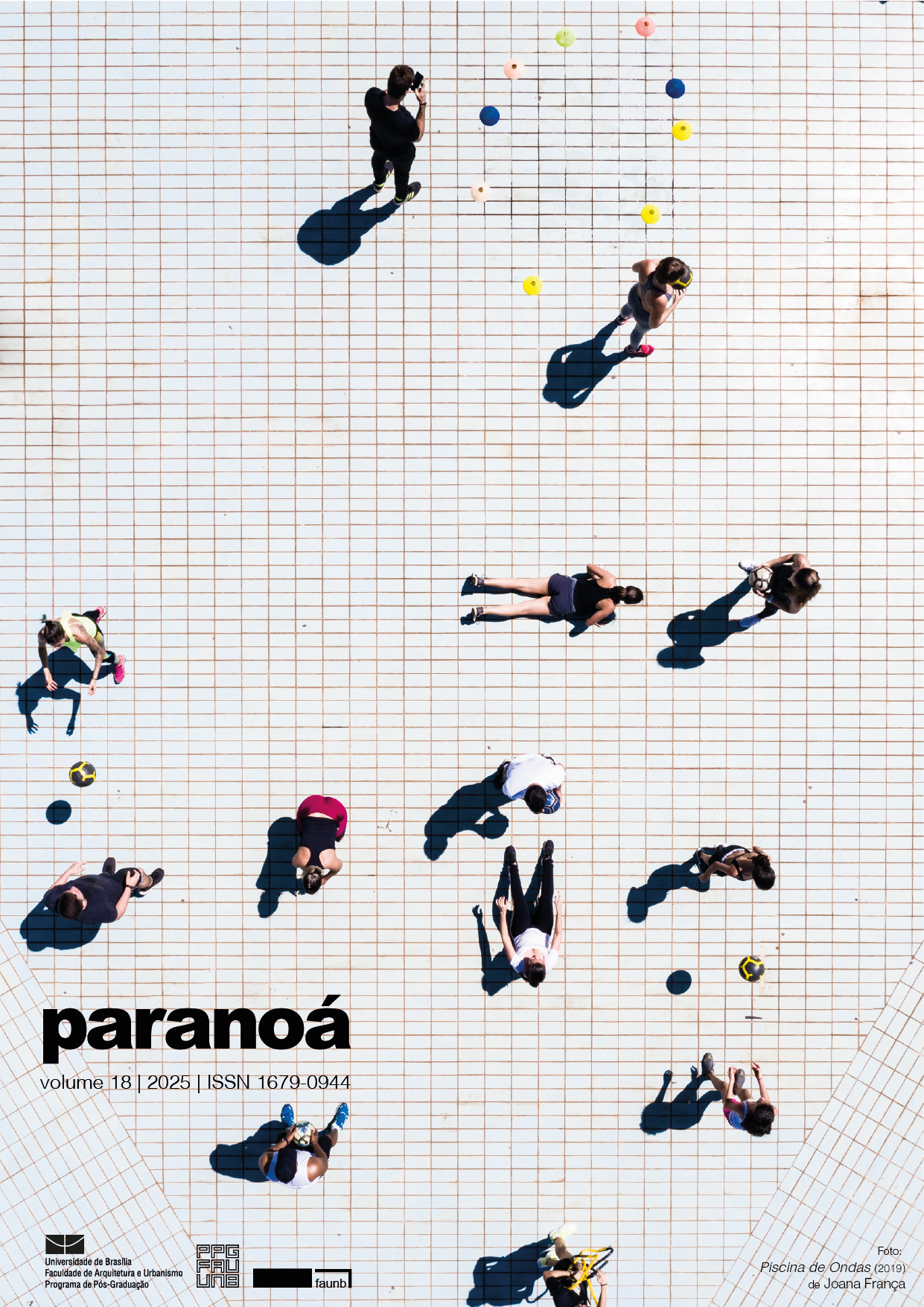Efecto de la vegetación en el microclima urbano
estudio de caso en Río de Janeiro con simulaciones en ENVI-met
DOI:
https://doi.org/10.18830/1679-09442025v18e54530Palabras clave:
Microclima Urbano, Temperatura Atmosférica, Conforto Higrotérmico, VegetaciónResumen
Este artículo tiene como objetivo analizar la influencia de la vegetación en una calle de Río de Janeiro, ubicada en un barrio consolidado, evaluando el impacto de diferentes escenarios en la temperatura del aire y la humedad relativa mediante simulaciones computacionales con el software ENVI-met 5 y el lenguaje de programación Python. Se comparó la situación existente de la calle en el año 2018 con siete escenarios hipotéticos diferentes, utilizando dos especies de vegetación arbórea, cubiertas y fachadas verdes. Se encontró que: [1] bajo las condiciones climáticas adoptadas, las diferencias entre los escenarios fueron pequeñas; [2] la adopción de diferentes especies arbóreas y la variación de su cantidad no produjo resultados promedio significativos; [3] a partir de las características morfológicas de la calle Fernando Osório, el uso de fachadas verdes obtuvo las temperaturas más bajas y las mayores humedades relativas promedio y puntuales entre los escenarios; [4] para alcanzar buenos niveles higrotérmicos en las calles de los centros urbanos consolidados, garantizando la sostenibilidad y eficiencia general del sistema, se pueden adoptar soluciones combinadas de las diferentes aplicaciones de vegetación.
Descargas
Citas
AKBARI, Hashem. Potentials of urban heat island mitigation. In: INTERNATIONAL CONFERENCE PASSIVE AND LOW ENERGY COOLING FOR THE BUILT ENVIRONMENT, 11., Santorini, Grécia. Anais [...]. 2005. p. 13.
ALVARES, Clayton Alcarde; STAPE, José Luiz; SENTELHAS, Paulo Cesar; GONÇALVES, José Leonardo de Moraes; SPAROVEK, Gerd. Köppen’s climate classification map for Brazil. Meteorologische Zeitschrift, Stuttgart, 2013. v. 22, n. 6, p. 711–728. DOI: 10.1127/0941-2948/2013/0507.
BAO, Jin; XU, Lihua; SHI, Yijun; MA, Qiwei; LU, Zhangwei. The influence of street morphology on thermal environment based on ENVI-met simulation: a case study of Hangzhou core area, China. ISPRS International Journal of Geo-Information, 2023. v. 12, n. 8, p. 303. DOI: https://doi.org/10.3390/ijgi12080303.
BARROS, C. P. G.; COSTA, S. B.; BARBOSA, R. V. R. Vegetação e microclima urbano: estudo de caso em ruas residenciais de bairros litorâneos em Maceió-Alagoas. In: CONGRESSO LUSO-BRASILEIRO PARA O PLANEJAMENTO URBANO, REGIONAL, INTEGRADO E SUSTENTÁVEL, 7., Maceió, Alagoas. Anais [...]. Maceió. 2016.
BONAN, Gordon B. Effects of land use on the climate of the United States. Climate Change, 1997. n. 37, p. 449–486. DOI: https://doi.org/10.1023/A:1005305708775.
BOZONNET, Emmanuel; DOYA, Maxime; ALLARD, Francis. Cool roofs impact on building thermal response: a French case study. Energy and Buildings, 2011. v. 43, n. 11, p. 3006–3012. DOI: https://doi.org/10.1016/j.enbuild.2011.07.017.
BRUSE, Michael. Simulating human thermal comfort and resulting usage patterns of urban open spaces with a multi-agent system. In: WITTKOPF, St.; TAN, B. K. 24th International Conference on Passive and Low Energy Architecture PLEA. Anais [...]. 2007. p. 699-706.
CARFAN, Ana Cláudia. Análise do conforto térmico em áreas abertas no município de Ourinhos – SP. 2011. 2011. Tese (Doutorado em Ciências) – Universidade de São Paulo, São Paulo.
CARFAN, Ana Cláudia; GALVANI, Emerson; NERY, Jonas Teixeira. Study of the microclimate effect in the urban vertical structure in Ourinhos, São Paulo State. Acta Scientiarum Technology, 2012. v. 34, n. 3, p. 313–320. DOI: https://doi.org/10.4025/actascitechnol.v34i3.12322.
CUI, Dongjin; CHEN, Yutong; ZHANG, Yu; LI, Xiangyi. A study on the effect of vertical greening on the thermal environment of street canyons based on ENVI-met simulation. E3S Web of Conferences. v. 490. Anais[…]. 2024. DOI: https://doi.org/10.1051/e3sconf/202449003004.
DAS, Niamjit. Modeling develops to estimate leaf area and leaf biomass of Lagerstroemia speciosa in West Vanugach Reserve Forest of Bangladesh. ISRN Forestry, 2014. v. 2014, p. 1–9. DOI: https://doi.org/10.1155/2014/486478.
EMMANUEL, Rohinton; ROSENLUND, Hans; JOHANSSON, Erik. Urban shading: a design option for the tropics? A study in Colombo, Sri Lanka. Int. J. of Climatology, 2007. v. 27, n. 14, p. 1995–2004. DOI: https://doi.org/10.1002/joc.1609.
FEBLES, E. A. Ventosa. Ecology and reproductive biology of Trichilia Triacantha Urb. (Meliaceae). 1997. Tese (Mestrado em Biologia) – University of Puerto Rico Mayagüez Campus, Mayagüez, Porto Rico ,1997.
GAITANI, Niki; MIHALAKAKOU, Giouli; SANTAMOURIS, Mat. On the use of bioclimatic architecture principles in order to improve thermal comfort conditions in outdoor spaces. Building and Environment, 2007. v. 42, n. 1, p. 317–324. DOI: https://doi.org/10.1016/j.buildenv.2005.08.018.
GARCÍA, Ricardo J Santiago. Performance of native tree species planted under nurse trees for dry forest restoration in Puerto Rico. 2010. Tese (Mestrado em Agronomia) – University of Puerto Rico Mayagüez Campus, Mayagüez, Porto Rico , 2010.
GILL, Susannah; HANDLEY, John F.; ENNOS, Adrian Roland; PAULEIT, Stephan. Adapting cities for climate change: the role of the green infrastructure. Built Environment, 2007. v. 33, n. 1, p. 115–133. DOI: https://doi.org/10.2148/benv.33.1.115.
GRIMMOND, C. S. B.; OKE, Timothe. R. An evapotranspiration-interception model for urban areas. Water Resources Research, 1991. n. 27, p. 1739–1755. DOI: https://doi.org/10.1029/91WR00557.
GUSSON, Carolina dos Santos; DUARTE, Denise Helena Silva; Effects of built density and urban morphology on urban microclimate: calibration of the model ENVI-met V4 for the subtropical Sao Paulo, Brazil. Em: INTERNATIONAL CONFERENCE ON COUNTERMEASURES TO URBAN HEAT ISLAND, 4., Singapura. Anais [...]. Singapura: Procedia Engineering. 2016.
IBGE. Brasil em números. Disponível em: https://biblioteca.ibge.gov.br/visualizacao/periodicos/2/bn_2021_v29.pdf. Acesso em: 23 jun. 2022.
LASMAR, Caio Ismael de Jesus; NUNES, Dorisvalder Dias. Elementos morfológicos urbanos e o campo termo-higrométrico na cidade de Porto Velho (RO). Revista Brasileira de Climatologia, 2022. v. 31, p. 180–206. DOI: https://doi.org/10.55761/abclima.v31i18.15860.
LEVINSON, Ronnen; BERDAHL, Paul; BERHE, Asmeret Asefaw; AKBARI, Hashem. Effects of soiling and cleaning on the reflectance and solar heat gain of a light-colored roofing membrane. Atmospheric Environment, 2005. v. 39, n. 40, p. 7807–7824. DOI: https://doi.org/10.1016/j.atmosenv.2005.08.037.
LIU, Zhixin; CHENG, Ka Yuen; SINSEL, Tim; SIMON, Helge; JIM, C.Y.; MORAKINYO, Tobi Eniolu; HE, Yueyang; YIN, Shi; OUYANG, Wanlu; SHI, Yuan; NG, Edward. Modeling microclimatic effects of trees and green roofs/façades in ENVI-met: sensitivity tests and proposed model library. Building and Environment, v. 244, p. 110759. 2023. DOI: https://doi.org/10.1016/j.buildenv.2023.110759.
LOIS, Erika; LABAKI, Lucila Chebel. Conforto térmico em espaços externos: uma revisão. In: ENCONTRO NACIONAL E ENCONTRO LATINO-AMERICANO SOBRE CONFORTO NO AMBIENTE CONSTRUÍDO, VI., São Pedro. Anais [...]. 2001.
LORENZI, Harri. Árvores brasileiras: manual de identificação e cultivo de plantas arbóreas nativas do Brasil. São Paulo: Editora Plantarum. 1992.
LUO, Tianqing; LIU, Yifan; ZHAI, Yujia; GONG, Xiuqi. Is LCZ Enough? Physical Properties, Thermal Environments and Cooling Effects of Green Roofs in High-Density Urban Industrial Blocks. Land, v. 13, n. 10, p. 1642, 9 out. 2024. DOI: https://doi.org/10.3390/land13101642./
MATHIEU, Renaud; FREEMAN, Claire; ARYAL, Jagannath. Mapping private gardens in urban areas using object-oriented techniques and very high-resolution satellite imagery. Landscape and Urban Planning, 2007. v. 81, p. 179–192. DOI: https://doi.org/10.1016/j.landurbplan.2006.11.009.
MINELLA, Flavia Cristina Osaku, KRÜGER, Eduardo Leite. Proposição do índice "fração vegetada" e sua relação com alterações na temperatura do ar e no conforto térmico no período diurno e em situação de verão para Curitiba. Ambiente Construído. 2017. v. 17(1), DOI: https://doi.org/10.1590/s1678-86212017000100139.
MUGHAL, Muhammad Omer; KUBILAY, Aytac; YÜCEL, Mehmet; AFACAN, Osman. Urban heat island intensity in Erzincan City: effects of urbanization and water bodies. Atmosphere, 2019. v. 10, n. 9, p. 543. DOI: https://doi.org/10.3390/atmos10090543.
NOVAES, Gabriel Bonansea De Alencar; MONTEIRO, Leonardo Marques. Calibração do ENVI-met para simulações termodinâmicas de espaços urbanos abertos em dias quentes. Ambiente Construído, v. 22, n. 4, p. 275–297, dez. 2022. DOI: https://doi.org/10.1590/s1678-86212022000400640.
OKE, Timothe. R. The micrometeorology of the urban forest. Philosofical Transaction of the Royal Society B, Londres, n. 324, p. 335–349, 1988. DOI: 10.1098/rstb.1989.0051.
OLIPHANT, Travis E. Python for scientific computing. Computing in Science & Engineering, v. 9, n. 3, p. 10-20, 2007. DOI: 10.1109/MCSE.2007.58.
PENG, Lilliana; JIM, C. Green-Roof Effects on Neighborhood Microclimate and Human Thermal Sensation. Energies, v. 6, n. 2, p. 598–618, 25 jan. 2013. DOI: https://doi.org/10.3390/en6020598.
RIO DE JANEIRO, Prefeitura Municipal do. Meio Ambiente. Parques e Jardins. Plano Diretor de Arborização Urbana da Cidade do Rio de Janeiro. Rio de Janeiro, 2015.
SFAKIANAKI, Aikaterini; PAGALOU, Elli; PAVLOU, Konstantinos; SANTAMOURIS, Mat; ASSIMAKOPOULOS, M. N. Theoretical and experimental analysis of the thermal behaviour of a green roof system installed in two residential buildings in Athens, Greece. Int. J. Energy Res., v. 33, p. 1059-1069, 2009. DOI: https://doi.org/10.1002/er.1535.
SHINZATO, Paula; SIMON, Helge; DUARTE, Denise Helena Silva; BRUSE, Michael. Calibration process and parametrization of tropical plants using ENVI-met V4: Sao Paulo case study. Architectural Science Review, v. 62, n. 2, p. 112-125, 2018.
SHINZATO, Paula. Impacto da vegetação nos microclimas urbanos em função das interações solo-vegetação-atmosfera. 2014. Tese (Doutorado em Tecnologia da Arquitetura) – Universidade de São Paulo, São Paulo, 2014. DOI: 10.11606/T.16.2014.tde-12092014-115829. Disponível em: http://www.teses.usp.br/teses/disponiveis/16/16132/tde-12092014-115829/. Acesso em: 22 dez. 2021.
SHINZATO, Paula; DUARTE, Denise Helena Silva. Impacto da vegetação nos microclimas urbanos e no conforto térmico em espaços abertos em função das interações solo-vegetação-atmosfera. Ambiente Construído, v. 18(2), 2018, DOI: https://doi.org/10.1590/s1678-86212018000200250
STEWART, I. D.; OKE, T. R. Local Climate Zones for Urban Temperature Studies. Bulletin of the American Meteorological Society, v. 93, n. 12, p. 1879–1900, 2012. DOI: https://doi.org/10.1175/BAMS-D-11-00019.1.
TAHA, Haider; AKBARI, Hashem; ROSENFELD, Arthur; HUANG, Joe. Residential cooling loads and the urban heat island—the effects of albedo. Building and Environment, v. 23, n. 4, p. 271–283, 1988. DOI: https://doi.org/10.1016/0360-1323(88)90033-9.
THEODOSIOU, Theodore. Green Roofs in Buildings: Thermal and Environmental Behaviour. Adv. Build. Energy Research, v. 3, p. 271–288, 2009. DOI: https://doi.org/10.3763/aber.2009.0311.
WALES, Scott. Reading ENVI_MET files. 2022. Disponível em: https://climate-cms.org/posts/2018-04-24-reading-envi-met.html. Acesso em: 26 ago. 2024.
WANG, Haihua; CAI, Yue; DENG, Weifen; LI, Chong; DONG, Ya; ZHOU, Lv; SUN, Jingyi.; LI, Chen; SONG, Bingzheng; ZHANG, Fangfang; ZHOU, Guomo. The Effects of Tree Canopy Structure and Tree Coverage Ratios on Urban Air Temperature Based on ENVI-Met. Forests, v. 14, n. 1, p. 80, 1 jan. 2023. DOI: https://doi.org/10.3390/f14010080.
XIAO, Tieqiao; SHENG, Lalan; ZHANG, Shaojie; ZHENG, Licheng; SHUI, Taotao. Thermal Comfort Improvement Strategies for Outdoor Spaces in Traditional Villages Based on ENVI-met: Shimengao Village in Chizhou City. Sustainability, v. 15, n. 15, p. 11785, 31 jul. 2023. DOI: https://doi.org/10.3390/su151511785.
Descargas
Publicado
Cómo citar
Número
Sección
Licencia
Derechos de autor 2025 Paranoá

Esta obra está bajo una licencia internacional Creative Commons Atribución 4.0.
Autores que publicam nesta revista concordam com os seguintes termos:
- Autores mantém os direitos autorais e concedem à revista o direito de primeira publicação, com o trabalho simultaneamente licenciado sob a Licença Creative Commons Attribution que permite o compartilhamento do trabalho com reconhecimento da autoria e publicação inicial nesta revista. http://creativecommons.org/licenses/by/4.0
- Autores têm autorização para assumir contratos adicionais separadamente, para distribuição não-exclusiva da versão do trabalho publicada nesta revista (ex.: publicar em repositório institucional ou como capítulo de livro), com reconhecimento de autoria e publicação inicial nesta revista.
- Autores têm permissão e são estimulados a publicar e distribuir seu trabalho online (ex.: em repositórios institucionais ou na sua página pessoal) a qualquer ponto antes ou durante o processo editorial, já que isso pode gerar alterações produtivas, bem como aumentar o impacto e a citação do trabalho publicado (Veja O Efeito do Acesso Livre).















